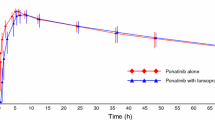Abstract
Omeprazole, a proton pump inhibitor, was given intravenously (iv), orally (po), intraperitoneally (ip), hepatoportalvenously (pv), and intrarectally (ir) to rats at a dose of 72mg/kg in order to investigate the bioavailability of the drug. The extent of bioavailabilities of omeprazole administered through pv, ip, po, and ir routes were 88.5, 79.4, 40.8, and 38.7%, respectively. Pharmacokinetic analysis in this study and literatures (Regardhet al., 1985: Watanabeet al., 1994) implied significant dose-dependency in hepatic first-pass metabolism, clearance and distribution, and acidic degradation in gastric fluid. The high bioavailability from the pv administration (88.5%) means that only 11.5% of dose was extracted by the first-pass metabolism through the liver at this dose (72 mg/kg). The low bioavailability from the oral administration (40.8%) in spite of minor hepatic first-pass extraction indicates low transport of the drug from GI lumen to portal vein. From the literature (Pilbrant and Cederberg, 1985), acidic degradation in gastric fluid was considered to be the major cause of the low transport. Thus, enteric coating of oral preparations would enhance the oral bioavailability substantially. The bioavailability of the drug from the rectal route, in which acidic degradation and hepatic first-pass metabolism may not occur, was low (38.7%) but comparable to that from the oral route (40.8%) indicating poor transport across the rectal membrane. In this case, addition of an appropriate absorption enhancer would improve the bioavailability. Rectal route seems to be an possible alternative to the conventional oral route for omeprazole administration.
Similar content being viewed by others
References cited
Andersson, T., Olsson, R., Regardh, C.G. and Skanberg, I. Pharmacokinetics of14C-omeprazole in patients with liver cirrhosis.Clin. Pharmacokinet., 24, 71–78 (1993).
Amantea, M.A. and Narang, P.K. Improved procedure for quantitation of omeprazole and metabolites using reversed-phase high-performance liquid chromatography.J. Chromatogr., 426, 216–222 (1988).
Larsson, H., Mattsson, H., Sundell, G. and Carlsson, E. Animal pharmacodynamics of omeprazole. A survey of the pharmacological properties of omeprazole in animals. Scand.J. Gastroenterol., 20 (suppl. 108), 23–35 (1985).
Lind, T., Andersson, T., Skanberg, I. and Olbe, L. Biliary excretion of intravenous14C-omeprazole in humans.Clin. Pharmacol. Ther., 42, 504–508 (1987).
Naesdal, J., Andersson, T., Bodemar, G., Larsson, R. and Skanberg, I. Pharmacokinetics of14C-omeprazole in patients with impaired renal function.Clin. Pharmacol. Ther., 40, 344–351 (1986).
Nakashima, M., Kanamaru, M., Hashimoto, H., Takiguchi, Y., Mizuno, A., Kajiho, T., Oka, T. and Matsuda, Y. Phase I study of omeprazole: Single-dose and multiple-dose studies.Jpn. J. Pharmacol. Ther., 19, 667–679 (1988).
Pilbrant, A. and Cederberg, C. Development of an oral formulation of omeprazole. Scand.J. Gastroenterol., 20 (suppl. 108), 113–120 (1985).
Regardh, C.G., Gabrielsson, M., Hoffman, K.J., Lofberg, I. and Skanberg, I. Pharmacokinetics and metabolism of omeprazole in animals and man-an overview.Scand. J. Gastroenterol., 20 (suppl. 108), 79–94 (1985).
Regardh, C.G., Gabrielsson, M., Hoffman, K.J., Lofberg, I. and Skanberg, I. The pharmacokinetics of omeprazole in humans-a study of single intravenous and oral doses.Therap. Drug Monitor., 12, 163–172 (1990).
Wallmark, B., Lorenston, P. and Larsson, H. The mechanism of action of omeprazole-a survey of its inhibitory actions in vitro.Scand. J. Gastroenterol., 20 (suppl. 108), 37–51 (1985).
Watanabe, K., Furuno, K., Eto, K., Oishi, R. and Gomita, Y. First-pass metabolism of omeprazole in rats.J. Pharm. Sci., 83, 1131–1134 (1994).
Yamaoka, K., Tanigawara, Y., Nakajima, T. and Uno, T. A pharmacokinetic analysis program (MULTI) for microcomputer.J. Pharmacobio-Dyn., 4, 879–885 (1981).
Author information
Authors and Affiliations
Rights and permissions
About this article
Cite this article
Choi, MS., Lee, YH. & Shim, CK. Bioavailabilities of omeprazole administered to rats through various routes. Arch. Pharm. Res. 18, 141–145 (1995). https://doi.org/10.1007/BF02979185
Received:
Issue Date:
DOI: https://doi.org/10.1007/BF02979185




